Galleries
‘The Pain Is Part of the Process’: Why Two Artists Are Pushing Body Modification to the Extreme
One of the artists, Tiamat Legion Medusa, is transforming into a dragon.
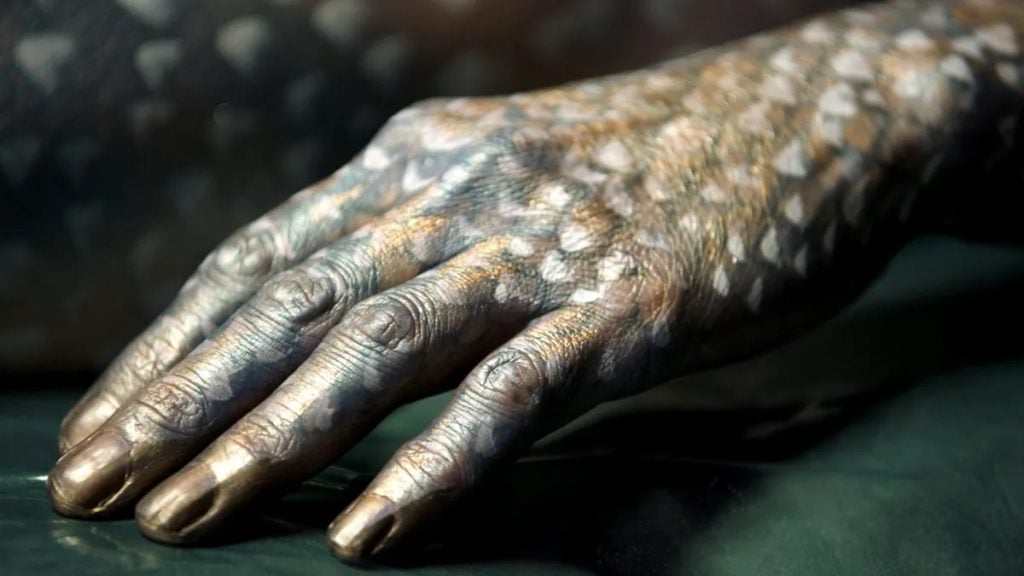
One of the artists, Tiamat Legion Medusa, is transforming into a dragon.

Sarah Cascone

Many people aren’t sure what to make of Tiamat Legion Medusa, the self-described most body-modified transexual in the world, who has transitioned not only from male to female, but from human to reptile. But for Carlos Motta, a Colombian artist whose practice is dedicated to documenting ways of challenging societal norms about sexuality and gender, it was immediately clear he was encountering an artist.
Shortly after meeting, the two were making plans to stage a performance piece together, combining Motta’s expertise in Shibari rope bondage with Medusa’s interest in suspensions, which allow the body to hang from metal hooks inserted into the skin.
Over the course of lockdown, the project evolved into a video piece, with both artists suspended from the ceiling in poses that seem extremely painful—Motta in an upside crucifixion, Medusa’s skin stretched taut by the ropes threaded though the hooks piercing chest, stomach, and legs.
The pair’s current gallery show, “When I Leave This World,” at New York’s OCDChinatown, also includes a second video in which Motta interviews Medusa about the decision to transition not only gender, but also species, and how that was rooted in childhood abuse.
Ahead of the exhibition’s closing weekend, we spoke to the two artists about their collaboration and friendship.
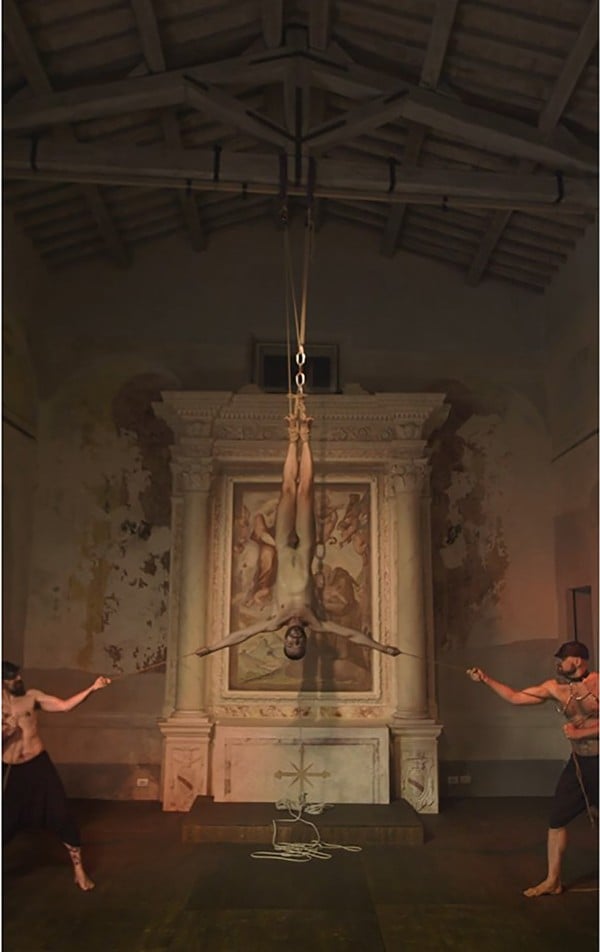
Carlos Motta, Inverted World (2016), video still. Photo courtesy of P.P.O.W., New York.
How did you two meet?
Motta: We met at a gay bar in Los Angeles called Precinct in the fall of 2019. I was hanging out with two of my friends, and Tiamat showed up looking like a fancy dragon. We liked each other’s vibes. I was fascinated about how Tiamat had decided to embark on this process of body modification—it was obvious Tiamat was a really creative soul.
Tiamat: I was glad that Carlos took the time to actually stop me and ask me questions. Some people run away from me. I was really appreciative that he didn’t run away. It made me feel very special. I have been painting and drawing ever since I was in the third grade—it’s a passion for me. It’s who I am.
What was your path to art like, Carlos?
Carlos: When I started making work I was doing mostly photography, with performative self-portraits. And then I decided to go to art school. I did a bachelors and a masters, and a fellowship at the Whitney Museum Independent Study Program. I had a very formal training as an artist.
I’m not a one-discipline type of artist. I’ve done a lot of video and sculpture and also performance. I’ve been more led by ideas and concepts, and then I find the form that I want to work in.
How did your collaboration come together?
Carlos: I showed you one of my inversion performances, this work Inverted World where I’m suspended by my feet in a chapel in Italy. I asked if you’d be open to doing something where we we performed together.
Tiamat: That’s exactly how the conversation went. I mentioned that I am an artist in the suspension world, only with hooks. My own conceptual art is my body art. I’m a walking and breathing work of art myself—I use my own body as my canvas as I turn myself into a human dragon through body modification.
Do doctors ever have concerns about the nature of the body modification procedures you are undergoing?
Tiamat: Actually, no. I don’t go to doctors for body modifications unless the procedures require going to the hospital, such as my orchiectomy—basically a castration, which was part of my transformation to become a genderless dragon.
Typically, I work with people who are called body modification specialists. They are artists who are helping me transform. I have no fear, because I only undergo the procedure if I trust the person. It’s very important that they know what they are doing. If not, the end result could be very bad.
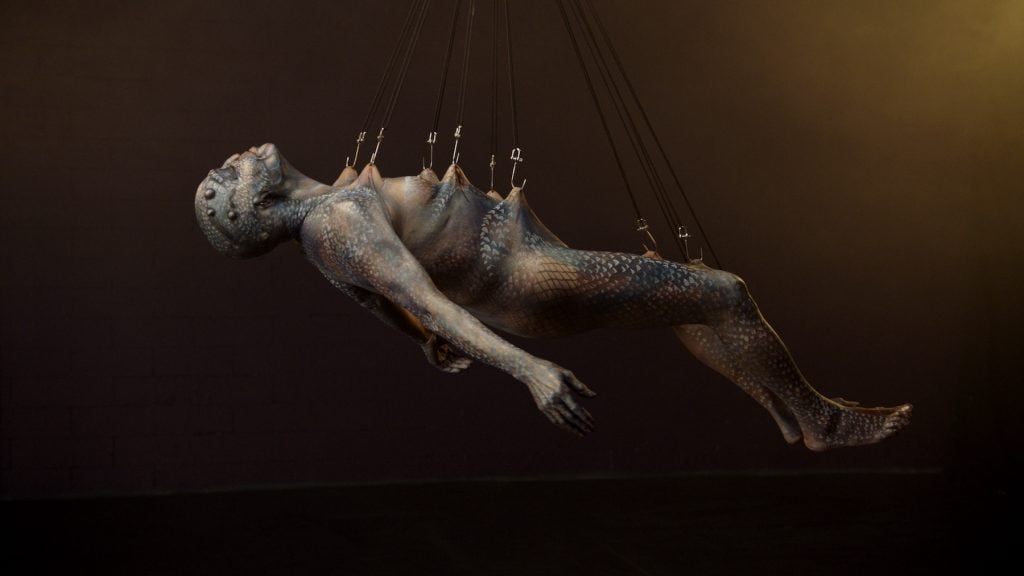
Carlos Motta and Tiamat Legion Medusa, When I Leave This World (2022), still. Courtesy of the artist, P.P.O.W. Gallery, and OCDChinatown.
In the second video, Tiamat, you also speak about being a longterm survivor of HIV. How is your health today?
Tiamat: I have gone from being on death’s door. I contracted AIDS in the 1990s when people were still dying left and right. I went through a whole bunch of treatments, and it almost killed me, but I survived. I consider myself to be one of the lucky ones who are still here. I had to watch a lot of my friends pass. It was through perseverance that I was able to make it this far.
How did you decide on Tiamat’s make up in the film?
Carlos: The film and the make up were very much inspired by William Blake’s paintings. A friend recommended we work with Michael Mejia, a professional make up artist. The look took about eight hours to compete.
Tiamat: I had to take a couple of naps while he was working on me. That’s the most elaborate makeup session I’ve ever sat for, but it was absolutely worth it. I was so impressed. I was dumbfounded. He transformed me into something so beautiful with his artistry.
Carlos: Endurance performance projects typically involve spending a lot of time with others. Those eight hours were really bonding for them. There was also all the time we had to spend with the suspension artists. I think all those things translate into the work. There’s a certain kind of ethics of care that comes into play. You develop are bonds beyond the professional, they also become strong friendships.
I have to admit, I had a hard time watching the film, because the hooks looked so painful. Is it as bad as it looks, and how do you do it safely without ripping through the skin?
Tiamat: When a person suspends, the people facilitating the suspensions are professionals who know what they are doing. There is a certain protocol to ensure the suspension goes without the hooks tearing. They have to be placed properly, and skin has to be separated from the muscle tissue so that the hooks only go through the skin.
I myself go through a preparation process of fasting. I don’t eat the whole day beforehand, and I meditate to get myself psychologically prepared for the time that the hooks go in me.
The first time I did a suspension, I was really scared. I didn’t know that was going to happen. But it was something that I had to do. It was a spiritual thing for me. Still to this day, after all the suspensions I’ve done, there’s a little bit of fear of something possibly going wrong. But I trust my people.
The pain is part of the process, and it doesn’t last very long—at least not for me. Everyone who suspends has their own experience, and it’s a very beautiful and spiritual experience for me.
Carlos: The practice of endurance performance is one of training, when you have to learn to endure. The training is physical, and it’s also emotional, and it’s also spiritual. It’s also a practice of care. You have to work with people who know what they are doing. You don’t put yourself in the hands of novices, or people who are gong to be irresponsible with your body.
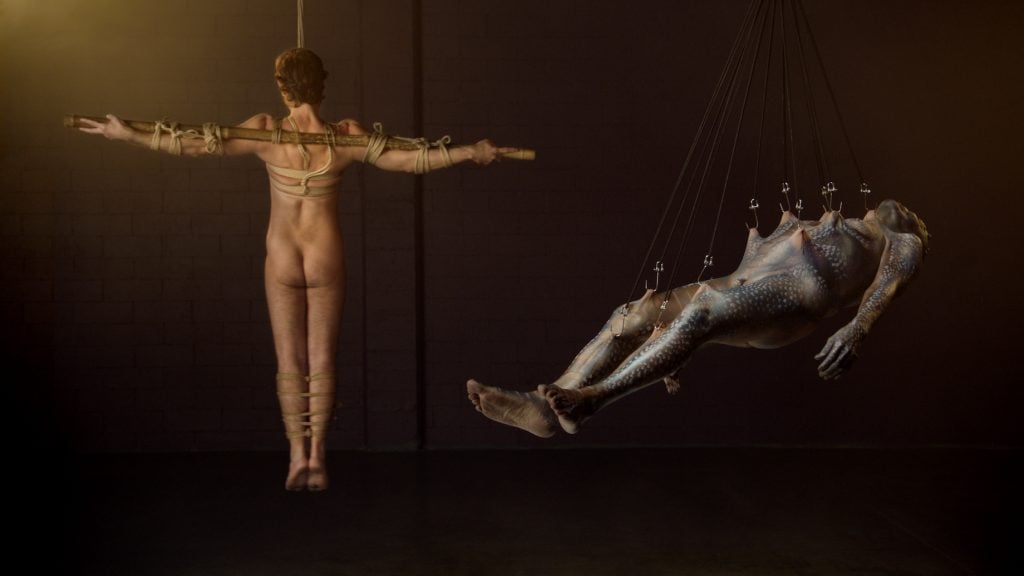
Carlos Motta and Tiamat Legion Medusa, When I Leave This World (2022), still. Courtesy of the artist, P.P.O.W. Gallery, and OCDChinatown.
How did you come to do this kind of performance, Carlos?
Carlos: In my personal life I’ve been interested in bondage for a long time. It’s something I’ve been doing with partners in non-public spaces. I started thinking about reenacting the crucifixion of St. Peter, and it became apparent to me that I wanted to take the practice out of the erotic space into my work. When I did Inverted World in 2016, it was the first time I did that in front of a camera as performative act of art, rather than an act of play in an erotic context.
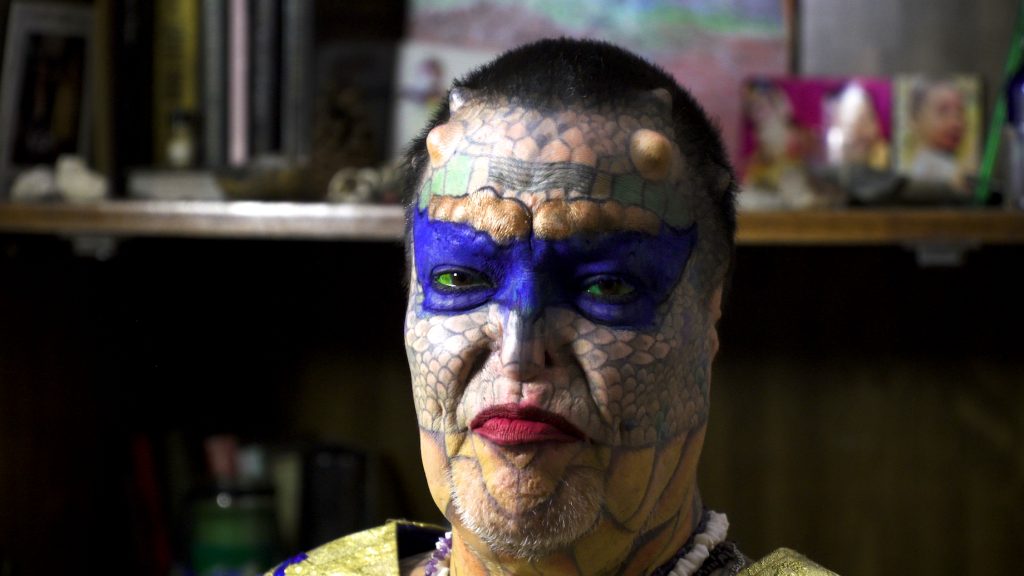
Carlos Motta and Tiamat Legion Medusa, When I Leave This World (2022), still. Courtesy of the artist, P.P.O.W. Gallery, and OCDChinatown.
How did these two practices come together for this show?
Carlos: Both Tiamat and I are very interested in mythology, and also the myths of Christianity, and the ways that these myths have conditioned the ways in which gender and sexually different people are marginalized. We wanted to use this image of both of us suspending to address ideas about what it means to sin, for example, or what the role of the serpent or the reptile is in the Catholic imagination around sexuality or gender or eroticism.
The suspension video is beautiful, but it needs context. There is a lot of Tiamat’s life and biography that is reflected in the suspension. The body modification and piercings and endurance of pain, all of these things are very much connected to your path, your transitions and your life. I thought it was important for the work to have this interview with Tiamat speaking about how life has treated you and the decisions you’ve made around that.
Tiamat: That’s true. A lot of people are concerned about the pain. As the hooks went in me and hanging from the hooks and being raised up was extremely painful. When I put my hands up in the video, I was trying to reach out for something to hang onto. It was so intense. Once I my body’s endorphins kicked in, I was able to let go and let loose. I took a real deep breath, and exhaled slowly. Then I was able to relax.
But I compare the pain of suspension to the pains I have had to endure as a human being, and how much I have been hurt by people. I converted that pain to the pain of the suspension, and let it go. It was about letting it go.
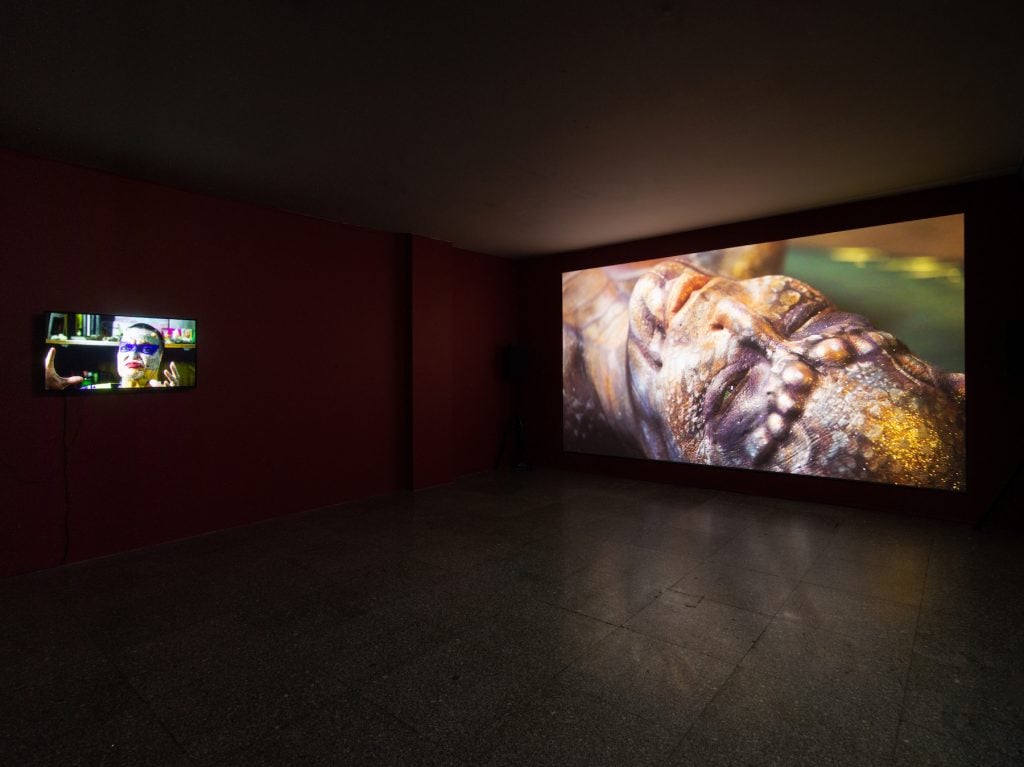
Carlos Motta and Tiamat Legion Medusa, When I Leave This World (2022), installation view at OCDChinatown. Courtesy of the artist and OCDChinatown.
Would you also equate that to letting go of your humanity in this trans-species journey that you’re on?
Tiamat: Yes, absolutely. It was like a rite of passage for me, going from human to reptile. It all has to be with being abandoned by my mother and my stepfather in the woods at nighttime when I in the first grade. That’s when I accepted that my parents were no longer humans, but my parents were reptilians.
I am more comfortable with the pronoun it, but the female pronoun is also acceptable. I consider myself to be non-binary in terms of gender. So as far as pronouns go, all pronouns go out the window.
“When I Leave This World: Carlos Motta and Tiamat Legion Medusa” is on view at OCDChinatown, 75 East Broadway, New York, February 11–April 10, 2022.